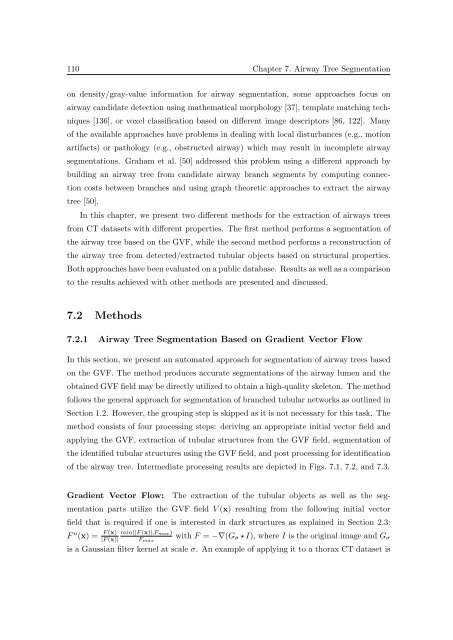Segmentation of 3D Tubular Tree Structures in Medical Images ...
Segmentation of 3D Tubular Tree Structures in Medical Images ...
Segmentation of 3D Tubular Tree Structures in Medical Images ...
You also want an ePaper? Increase the reach of your titles
YUMPU automatically turns print PDFs into web optimized ePapers that Google loves.
110 Chapter 7. Airway <strong>Tree</strong> <strong>Segmentation</strong><br />
on density/gray-value <strong>in</strong>formation for airway segmentation, some approaches focus on<br />
airway candidate detection us<strong>in</strong>g mathematical morphology [37], template match<strong>in</strong>g techniques<br />
[136], or voxel classification based on different image descriptors [86, 122]. Many<br />
<strong>of</strong> the available approaches have problems <strong>in</strong> deal<strong>in</strong>g with local disturbances (e.g., motion<br />
artifacts) or pathology (e.g., obstructed airway) which may result <strong>in</strong> <strong>in</strong>complete airway<br />
segmentations. Graham et al. [50] addressed this problem us<strong>in</strong>g a different approach by<br />
build<strong>in</strong>g an airway tree from candidate airway branch segments by comput<strong>in</strong>g connection<br />
costs between branches and us<strong>in</strong>g graph theoretic approaches to extract the airway<br />
tree [50].<br />
In this chapter, we present two different methods for the extraction <strong>of</strong> airways trees<br />
from CT datasets with different properties. The first method performs a segmentation <strong>of</strong><br />
the airway tree based on the GVF, while the second method performs a reconstruction <strong>of</strong><br />
the airway tree from detected/extracted tubular objects based on structural properties.<br />
Both approaches have been evaluated on a public database. Results as well as a comparison<br />
to the results achieved with other methods are presented and discussed.<br />
7.2 Methods<br />
7.2.1 Airway <strong>Tree</strong> <strong>Segmentation</strong> Based on Gradient Vector Flow<br />
In this section, we present an automated approach for segmentation <strong>of</strong> airway trees based<br />
on the GVF. The method produces accurate segmentations <strong>of</strong> the airway lumen and the<br />
obta<strong>in</strong>ed GVF field may be directly utilized to obta<strong>in</strong> a high-quality skeleton. The method<br />
follows the general approach for segmentation <strong>of</strong> branched tubular networks as outl<strong>in</strong>ed <strong>in</strong><br />
Section 1.2. However, the group<strong>in</strong>g step is skipped as it is not necessary for this task. The<br />
method consists <strong>of</strong> four process<strong>in</strong>g steps: deriv<strong>in</strong>g an appropriate <strong>in</strong>itial vector field and<br />
apply<strong>in</strong>g the GVF, extraction <strong>of</strong> tubular structures from the GVF field, segmentation <strong>of</strong><br />
the identified tubular structures us<strong>in</strong>g the GVF field, and post process<strong>in</strong>g for identification<br />
<strong>of</strong> the airway tree. Intermediate process<strong>in</strong>g results are depicted <strong>in</strong> Figs. 7.1, 7.2, and 7.3.<br />
Gradient Vector Flow:<br />
The extraction <strong>of</strong> the tubular objects as well as the segmentation<br />
parts utilize the GVF field V (x) result<strong>in</strong>g from the follow<strong>in</strong>g <strong>in</strong>itial vector<br />
field that is required if one is <strong>in</strong>terested <strong>in</strong> dark structures as expla<strong>in</strong>ed <strong>in</strong> Section 2.3:<br />
F n (x) = F (x) m<strong>in</strong>(|F (x)|,F max)<br />
|F (x)| F max<br />
with F = −∇(G σ ⋆ I), where I is the orig<strong>in</strong>al image and G σ<br />
is a Gaussian filter kernel at scale σ. An example <strong>of</strong> apply<strong>in</strong>g it to a thorax CT dataset is















